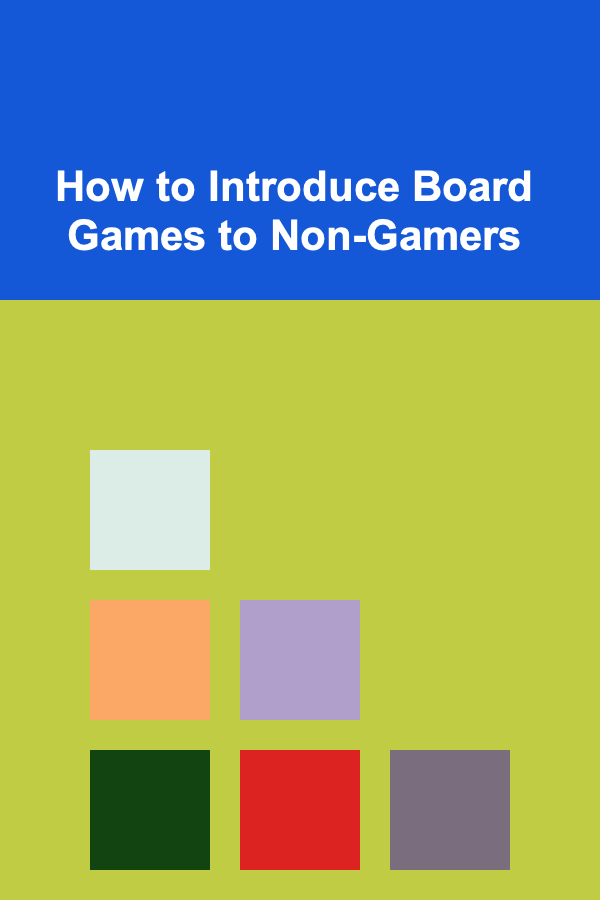
How to Introduce Board Games to Non-Gamers
ebook include PDF & Audio bundle (Micro Guide)
$12.99$11.99
Limited Time Offer! Order within the next:

Board games have long been a source of entertainment and social connection, yet they often remain an untapped treasure for many non-gamers. While gaming culture has grown in recent years, with many new and exciting games emerging in various genres, the barrier to entry can be intimidating for those who are unfamiliar with board games. Non-gamers may be hesitant to dive into a world that seems complex or time-consuming, preferring to stick with their usual forms of entertainment, like video games, television, or socializing in other ways. However, introducing board games to non-gamers doesn't have to be a daunting task.
In this article, we will explore the steps and strategies for introducing board games to non-gamers, offering tips on how to ease them into this fun and social hobby. The goal is to create a welcoming and enjoyable experience that encourages them to embrace board gaming as a regular part of their social activities.
Understand the Audience
The first step in introducing board games to non-gamers is understanding your audience. Not all non-gamers are the same, and their level of engagement with games or their preferences may vary. Some individuals may be intimidated by the complexity of traditional board games, while others might be curious but unsure where to start. By recognizing these differences, you can select the right type of game and approach to ensure a positive experience.
Consider Interests and Preferences
Take into account the non-gamer's personal interests. For example:
- If they enjoy storytelling, games like Dixit or Codenames might appeal to them.
- If they enjoy problem-solving or strategy, games like Ticket to Ride or Carcassonne could be a good introduction.
- If they enjoy casual social activities, party games like Pictionary or Telestrations might be the best starting point.
Gauge Their Level of Comfort
Consider whether the person is open to learning new things or if they are more cautious. You want to introduce them to games that they can easily grasp without feeling overwhelmed.
Start with Simple, Easy-to-Learn Games
When introducing board games to non-gamers, it is crucial to start with simple games that are easy to learn and understand. Complicated games with heavy rulebooks or long playing times can quickly discourage newcomers from wanting to play again. Look for games that are intuitive, have a quick setup, and can be learned within a short time frame.
Examples of Beginner-Friendly Games:
- Uno: A card game that everyone can enjoy, with simple rules and quick gameplay.
- Sushi Go!: A fast-paced, easy-to-learn card game where players collect sushi dishes to score points.
- King of Tokyo: A fun and casual game where players take on the role of monsters battling for control of Tokyo, with straightforward mechanics and engaging dice rolls.
These games are excellent choices for introducing non-gamers to the world of board games, as they do not require extensive knowledge of game mechanics and can be played in under 30 minutes.
Focus on Social Interaction, Not Just Winning
For non-gamers, the appeal of board games often lies more in the social interaction than in the competitive aspect. While many traditional gamers are motivated by strategy and victory, non-gamers are more likely to enjoy games that foster communication, laughter, and connection with others. Therefore, choose games that encourage conversation, teamwork, and creativity rather than focusing solely on competition.
Social Games to Consider:
- Codenames: A word association game that encourages players to think creatively and communicate effectively.
- Telestrations: A drawing and guessing game that leads to hilarious misunderstandings and shared moments of fun.
- Dixit: A beautifully illustrated game of storytelling that relies on players' creativity to describe cards, fostering collaboration and imagination.
By focusing on games that emphasize interaction and fun, you will ensure that the experience is enjoyable for everyone, whether or not they are competitive.
Keep Sessions Short and Sweet
One of the key reasons why non-gamers may hesitate to try board games is the perceived time commitment. Many non-gamers are used to entertainment that is quick and easy to consume, such as short YouTube videos or TV shows. As such, long and complex games can seem daunting. To alleviate this, it's essential to keep the game sessions short and manageable, especially when first introducing board games.
Time-Friendly Games:
- Love Letter: A quick card game where players try to win the favor of the princess by sending her secret love letters. A game typically lasts 15 minutes.
- Splendor: A simple strategy game about collecting gems and building a successful trading network, which can be played in under 30 minutes.
- Exploding Kittens: A fast-paced and easy-to-learn card game with quirky humor and quick gameplay, ideal for a short game session.
Starting with shorter games gives non-gamers the opportunity to experience the fun of board gaming without feeling like they're committing hours of their time.
Explain the Rules Clearly and Briefly
When teaching a new game, it's important to explain the rules in a way that is both clear and concise. Non-gamers might not be accustomed to complex instructions or terminology, so it's crucial to break down the rules in a straightforward manner. Avoid overwhelming them with too much information at once. Start by explaining the basic mechanics and objectives of the game before diving into any advanced strategies or edge cases.
Tips for Explaining Rules:
- Keep it Simple: Focus on the core concepts and the flow of the game.
- Use Analogies: If the game shares similarities with something they already know, such as card games or board games, highlight those similarities.
- Show, Don't Just Tell: Rather than simply explaining, set up the game and demonstrate how a turn works. This hands-on approach helps make the learning process easier.
- Be Patient: Allow the non-gamer to ask questions and ensure they feel comfortable before starting. Reassure them that they will understand more as the game progresses.
A helpful rule of thumb is to aim for a 5-10 minute explanation for simpler games and keep it even shorter for very straightforward games.
Play Together and Guide Them Through the First Game
The best way to introduce board games to non-gamers is to play alongside them. Playing together allows you to guide them through the game while offering helpful tips and explanations in real time. It also creates an opportunity for everyone to bond over the experience. Be patient and encouraging as they learn the rules, and avoid being too competitive at first.
Things to Keep in Mind:
- Don't Overwhelm: Don't try to teach multiple games in one session. Focus on one game and ensure they're comfortable with it before moving on to others.
- Encourage Exploration: If they're unsure about their moves, encourage experimentation. Let them play at their own pace.
- Emphasize Fun: Remind them that the goal is to have fun, and don't stress the importance of winning.
Playing together allows the non-gamer to experience the flow of the game without feeling pressured. Your supportive presence will also help them feel more at ease as they start to engage with the game.
Offer a Variety of Game Types
While some non-gamers may be hesitant to try certain games, offering a variety of game types can increase their chances of finding something they enjoy. People have different tastes when it comes to board games. Some prefer cooperative games, while others might prefer competitive ones. By providing a selection of games across different genres, you allow them to explore the full range of what board gaming has to offer.
Game Types to Explore:
- Cooperative Games : Games where players work together to achieve a common goal, such as Pandemic or Forbidden Island.
- Competitive Games : Games where players compete against each other, like Monopoly or Ticket to Ride.
- Party Games : Games designed for large groups, such as Charades or Just One.
- Strategy Games : More in-depth games that require planning, like Catan or Carcassonne.
When you offer a variety of choices, non-gamers will feel more comfortable exploring different types of games to find something that suits their preferences.
Be Open to Feedback and Adjust
After the first few games, it's important to check in with your non-gamer friends and ask for their feedback. Were they enjoying themselves? Did they find the game too challenging or too simple? Do they want to try something else next time? By paying attention to their responses, you can adjust your approach and pick games that better suit their preferences.
Sometimes, they might find that certain games aren't for them, and that's okay. Use their feedback as a guide for future gaming sessions. The ultimate goal is to ensure they feel comfortable and excited about board gaming, even if that means trying out new games or different formats.
Make It a Regular Activity
One of the best ways to introduce board games to non-gamers is to make it a regular part of your social gatherings. By turning board gaming into a fun, routine activity, you help create an environment where everyone can feel comfortable and familiar with the process. Over time, non-gamers will develop more confidence in their ability to play and might even begin to seek out games themselves.
Ideas for Making Board Games a Regular Activity:
- Host a Game Night with different games each time.
- Start a Board Game Club with friends or family.
- Encourage non-gamers to bring their own game suggestions.
By consistently incorporating board games into your social life, you foster a space where non-gamers can feel more comfortable and open to the idea of gaming.
Conclusion
Introducing board games to non-gamers can be a fun and rewarding experience, but it requires patience, understanding, and the right approach. By choosing simple games, focusing on social interaction, and guiding your non-gamer friends through the learning process, you can help them discover the joy of board gaming. Whether they're drawn to competitive challenges, cooperative teamwork, or creative expression, board games offer something for everyone. With the right encouragement and the right games, non-gamers will soon be embracing the world of tabletop gaming, creating memorable experiences along the way.

How to Create a Checklist for Effective Project Documentation
Read More
How to Create a Weekly Meal Planning and Organization System
Read More
How to Invest in Bonds for Steady Income
Read More
How to Keep Your Home Free from Pet Allergens
Read More
How to Renovate Your Home with Sustainable and Recycled Materials
Read More
10 Tips for a Relationship To-Do List That Prioritizes Quality Time
Read MoreOther Products

How to Create a Checklist for Effective Project Documentation
Read More
How to Create a Weekly Meal Planning and Organization System
Read More
How to Invest in Bonds for Steady Income
Read More
How to Keep Your Home Free from Pet Allergens
Read More
How to Renovate Your Home with Sustainable and Recycled Materials
Read More